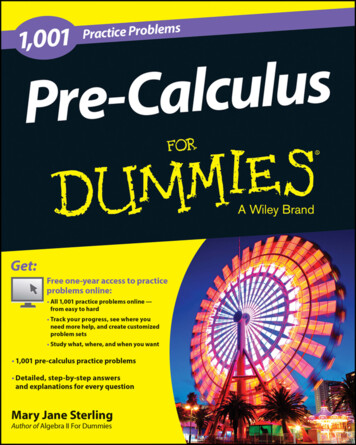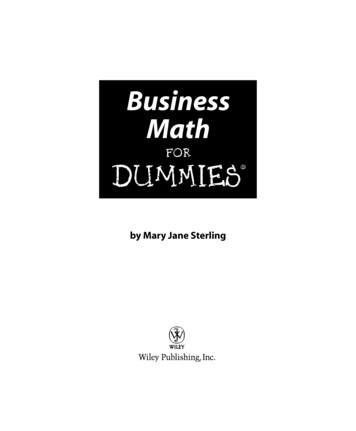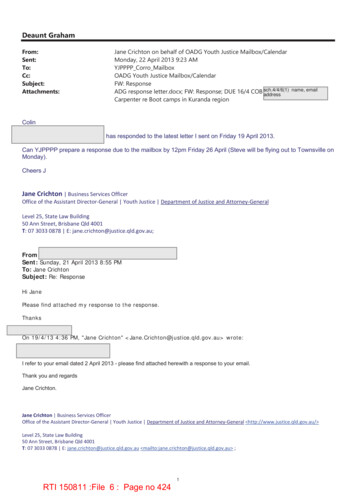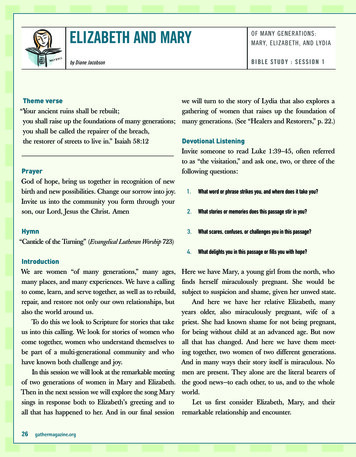
Transcription
suluclaCerP1,001smelborPecitcPraby Mary Jane Sterling
1,001 Pre-Calculus Practice Problems For Dummies Published by: John Wiley & Sons, Inc., 111 River Street, Hoboken, NJ 07030-5774, www.wiley.comCopyright 2014 by John Wiley & Sons, Inc., Hoboken, New JerseyPublished simultaneously in CanadaNo part of this publication may be reproduced, stored in a retrieval system or transmitted in any formor by any means, electronic, mechanical, photocopying, recording, scanning or otherwise, except aspermitted under Sections 107 or 108 of the 1976 United States Copyright Act, without the prior written permission of the Publisher. Requests to the Publisher for permission should be addressed to thePermissions Department, John Wiley & Sons, Inc., 111 River Street, Hoboken, NJ 07030, (201) 748-6011,fax (201) 748-6008, or online at http://www.wiley.com/go/permissions.Trademarks: Wiley, For Dummies, the Dummies Man logo, Dummies.com, Making Everything Easier, andrelated trade dress are trademarks or registered trademarks of John Wiley & Sons, Inc., and may not beused without written permission. All other trademarks are the property of their respective owners. JohnWiley & Sons, Inc., is not associated with any product or vendor mentioned in this book.LIMIT OF LIABILITY/DISCLAIMER OF WARRANTY: WHILE THE PUBLISHER AND AUTHOR HAVE USEDTHEIR BEST EFFORTS IN PREPARING THIS BOOK, THEY MAKE NO REPRESENTATIONS OR WARRANTIES WITH RESPECT TO THE ACCURACY OR COMPLETENESS OF THE CONTENTS OF THIS BOOKAND SPECIFICALLY DISCLAIM ANY IMPLIED WARRANTIES OF MERCHANTABILITY OR FITNESS FORA PARTICULAR PURPOSE. NO WARRANTY MAY BE CREATED OR EXTENDED BY SALES REPRESENTATIVES OR WRITTEN SALES MATERIALS. THE ADVICE AND STRATEGIES CONTAINED HEREIN MAYNOT BE SUITABLE FOR YOUR SITUATION. YOU SHOULD CONSULT WITH A PROFESSIONAL WHEREAPPROPRIATE. NEITHER THE PUBLISHER NOR THE AUTHOR SHALL BE LIABLE FOR DAMAGES ARISING HEREFROM.For general information on our other products and services, please contact our Customer Care Departmentwithin the U.S. at 877-762-2974, outside the U.S. at 317-572-3993, or fax 317-572-4002. For technical support,please visit www.wiley.com/techsupport.Wiley publishes in a variety of print and electronic formats and by print-on-demand. Some materialincluded with standard print versions of this book may not be included in e-books or in print-on-demand.If this book refers to media such as a CD or DVD that is not included in the version you purchased, youmay download this material at http://booksupport.wiley.com. For more information about Wileyproducts, visit www.wiley.com.Library of Congress Control Number: 2014936392ISBN 978-1-118-85332-0 (pbk); ISBN 978-1-118-85281-1 (ebk); ISBN 978-1-118-85334-4 (ebk)Manufactured in the United States of America10 9 8 7 6 5 4 3 2 1
Contents at a GlanceIntroduction. 1Part I: The Questions. 7Chapter 1: Getting Started with Algebra Basics. 9Chapter 2: Solving Some Equations and Inequalities. 15Chapter 3: Function Basics. 21Chapter 4: Graphing and Transforming Functions. 29Chapter 5: Polynomials. 37Chapter 6: Exponential and Logarithmic Functions. 45Chapter 7: Trigonometry Basics. 53Chapter 8: Graphing Trig Functions. 61Chapter 9: Get↜æ å ting Star↜æ å ted with Trig Identities. 67Chapter 10: Continuing with Trig Identities. 73Chapter 11: Working with Triangles and Trigonometry. 79Chapter 12: Complex Numbers and Polar Coordinates. 89Chapter 13: Conic Sections. 97Chapter 14: Systems of Equations and Inequalities. 103Chapter 15: Sequences and Series. 111Chapter 16: Introducing Limits and Continuity. 117Part II: The Answers. 125Chapter 17: Answers. 127Index. 527
Table of ContentsIntroduction. 1What You’ll Find. 1How This Workbook Is Organized. 2Part I: The Questions. 2Part II: The Answers. 3Beyond the Book. 3What you’ll find online. 3How to register. 4Where to Go for Additional Help. 4Part I: The Questions. 7Chapter 1: Getting Started with Algebra Basics . . . . . . . . . . . . . . . . . . . 9The Problems You’ll Work On. 9What to Watch Out For. 9Identifying Which System or Systems a Number Belongs To. 10Recognizing Properties of Number Systems. 10Simplifying Expressions with the Order of Operations. 11Graphing Inequalities. 12Using Graphing Formulas. 13Applying Graphing Formulas. 13Chapter 2: Solving Some Equations and Inequalities . . . . . . . . . . . . . . 15The Problems You’ll Work On. 15What to Watch Out For. 15Using Interval and Inequality Notation. 16Solving Linear Inequalities. 17Solving Quadratic Inequalities. 17Solving Absolute Value Inequalities. 17Working with Radicals and Fractional Notation. 18Performing Operations Using Fractional Exponents. 18Factoring Using Fractional Notation. 19Solving Radical Equations. 19Rationalizing Denominators. 20Chapter 3: Function Basics . . . . . . . . . . . . . . . . . . . . . . . . . . . . . . . . . . . . 21The Problems You’ll Work On. 21What to Watch Out For. 21Using Function Notation to Evaluate Function Values. 22Determining the Domain and Range of a Function. 22Recognizing Even Functions. 23Identifying Odd Functions. 23
vi1,001 Pre-Calculus Practice Problems For DummiesRuling Out Even and Odd Functions. 23Recognizing One-to-One Functions from Given Relations. 23Identifying One-to-One Functions from Equations. 25Recognizing a Function’s Inverse. 25Determining a Function’s Inverse. 26Executing Operations on Functions. 26Performing Function Composition. 27Doing More Function Composition. 27Using the Difference Quotient. 28Chapter 4: Graphing and Transforming Functions . . . . . . . . . . . . . . . . . 29The Problems You’ll Work On. 29What to Watch Out For. 29Functions and Their Inverses. 30Sketching Quadratic Functions from Their Equations. 30Writing Equations from Graphs of Parabolas. 31Investigating and Graphing Radical Functions. 32Investigating Absolute Value Functions. 33Investigating the Graphs of Polynomial Functions. 33Investigating Rational Functions. 34Transformation of Functions. 34Transforming Selected Points Using Functions. 34Sketching Graphs Using Basic Functions and Transformations. 35Sketching More Graphs Using Basic Functions and Transformations. 35Chapter 5: Polynomials . . . . . . . . . . . . . . . . . . . . . . . . . . . . . . . . . . . . . . . . 37The Problems You’ll Work On. 37What to Watch Out For. 37Using Factoring to Solve Quadratic Equations. 38Solving Quadratic Equations by Using the Quadratic Formula. 38Using Completing the Square to Solve Quadratic Equations. 39Solving Polynomial Equations for Intercepts. 39Using Factoring by Grouping to Solve Polynomial Equations. 40Applying Descartes’s Rule of Signs. 40Listing Possible Roots of a Polynomial Equation. 40Dividing Polynomials. 41Using Synthetic Division to Divide Polynomials. 41Checking for Roots of a Polynomial by Using Synthetic Division. 41Writing Polynomial Expressions from Given Roots. 42Writing Polynomial Expressions When Given Roots and a Point. 42Graphing Polynomials. 43Writing Equations from Graphs of Polynomials. 43Chapter 6: Exponential and Logarithmic Functions . . . . . . . . . . . . . . . 45The Problems You’ll Work On. 45What to Watch Out For. 45Understanding Function Notation. 46Graphing Exponential Functions. 46
Table of ContentsSolving Exponential Equations. 47Using the Equivalence bx y logb y x to Rewrite Expressions. 48Using the Equivalence logb y x bx y to Rewrite Expressions. 48Rewriting Logarithmic Expressions. 48Rewriting Logs of Products and Quotients as Sums and Differences. 49Solving Logarithmic Equations. 49Applying Function Transformations to Log Functions. 50Applying Logarithms to Everyday Life. 51Chapter 7: Trigonometry Basics . . . . . . . . . . . . . . . . . . . . . . . . . . . . . . . . 53The Problems You’ll Work On. 53What to Watch Out For. 53Using Right Triangles to Determine Trig Functions. 54Solving Problems by Using Right Triangles and Their Functions. 55Working with Special Right Triangles. 56Changing Radians to Degrees. 57Changing Degrees to Radians. 57Finding Angle Measures (in Degrees) in Standard Position. 57Determining Angle Measures (in Radians) in Standard Position. 58Identifying Reference Angles. 58Determining Trig Functions by Using the Unit Circle. 58Calculating Trig Functions by Using Other Functionsand Terminal Side Positions. 59Using the Arc Length Formula. 59Evaluating Inverse Functions. 60Solving Trig Equations for x in Degrees. 60Calculating Trig Equations for x in Radians. 60Chapter 8: Graphing Trig Functions . . . . . . . . . . . . . . . . . . . . . . . . . . . . . 61The Problems You’ll Work On. 61What to Watch Out For. 61Recognizing Basic Trig Graphs. 62Graphing Sine and Cosine. 64Applying Function Transformations to Graphs of Trig Functions. 64Writing New Trig Functions Using Transformations. 64Graphing Tangent and Cotangent. 65Interpreting Transformations of Trig Functions. 65Graphing Secant and Cosecant. 66Interpreting Transformations from Function Rules. 66Chapter 9: Get↜æ å ting Star↜æ å ted with Trig Identities . . . . . . . . . . . . . . . . . . . 67The Problems You’ll Work On. 67What to Watch Out For. 67Proving Basic Trig Identities. 68Returning to Basic Sine and Cosine to Solve Identities. 69Using Multiplication by a Conjugate to Solve Identities. 70Solving Identities After Raising a Binomial to a Power. 70Solving Identities After Factoring out a Common Function. 70vii
viii1,001 Pre-Calculus Practice Problems For DummiesSolving Identities After Combining Fractions. 71Performing Algebraic Processes to Make Identities More Solvable. 71Chapter 10: Continuing with Trig Identities . . . . . . . . . . . . . . . . . . . . . . 73The Problems You’ll Work On. 73What to Watch Out For. 73Using Identities That Add or Subtract Angle Measures. 74Confirming Double-Angle Identities. 74Using Identities That Double the Size of the Angle. 74Confirming the Statements of Multiple-Angle Identities. 74Creating Half-Angle Identities from Double-Angle Identities. 75Creating a Half-Angle Identity for Tangent. 75Using Half-Angle Identities to Simplify Expressions. 75Creating Products of Trig Functions from Sums and Differences. 75Using Product-to-Sum Identities to Evaluate Expressions. 75Using Sum-to-Product Identities to Evaluate Expressions. 76Applying Power-Reducing Identities. 76Using Identities to Determine Values of Functions at Various Angles. 76Working through Identities Using Multiple Methods. 77Chapter 11: Working with Triangles and Trigonometry . . . . . . . . . . . . 79The Problems You’ll Work On. 79What to Watch Out For. 79Applying the Law of Sines to Find Sides. 80Utilizing the Law of Sines to Find Angles. 80Using the Law of Sines for Practical Applications. 81Investigating the Ambiguous Case of the Law of Sines. 81Determining All Angles and Sides of a Triangle. 82Finding Side Measures by Using the Law of Cosines. 82Using the Law of Cosines to Determine an Angle. 82Applying the Law of Cosines to Real-World Situations. 83Finding Areas of Triangles by Using the Sine. 83Applying the Trig Formula for Area of a Triangle. 84Using the Trig Formula for Area in Various Situations. 84Solving Area Problems Needing Additional Computations. 85Finding Areas of Triangles by Using Heron’s Formula. 86Applying Heron’s Formula. 86Practical Applications Using Heron’s Formula. 87Tackling Practical Applications by Using Triangular Formulas. 87Chapter 12: Complex Numbers and Polar Coordinates . . . . . . . . . . . . 89The Problems You’ll Work On. 89What to Watch Out For. 89Writing Powers of i in Their Simplest Form. 90Adding and Subtracting Complex Numbers. 90Multiplying Complex Numbers. 91Using Multiplication to Divide Complex Numbers. 91Solving Quadratic Equations with Complex Solutions. 92Graphing Complex Numbers. 92Identifying Points with Polar Coordinates. 94
Table of ContentsIdentifying Points Whose Angles Have Negative Measures. 94Converting Polar to Rectangular Coordinates. 95Converting Rectangular to Polar Coordinates. 95Recognizing Polar Curves. 96Chapter 13: Conic Sections . . . . . . . . . . . . . . . . . . . . . . . . . . . . . . . . . . . . 97The Problems You’ll Work On. 97What to Watch Out For. 97Identifying Conics from Their Equations. 98Rewriting Conic Equations in Standard Form. 98Writing Equations for Circles. 98Determining Foci and Axes of Symmetry of Parabolas. 99Finding the Vertices and Directrixes of Parabolas. 99Writing Equations of Parabolas. 100Determining Centers and Foci of Ellipses. 100Writing Equations of Ellipses. 100Determining Asymptotes of Hyperbolas. 101Writing Equations of Hyperbolas. 101Changing Equation Format from Trig Functions to Algebraic. 101Changing Equation Format from Algebraic to Trig. 102Chapter 14: Systems of Equations and Inequalities . . . . . . . . . . . . . . 103The Problems You’ll Work On. 103What to Watch Out For. 104Using Substitution to Solve Systems of Linear Equationswith Two Variables. 104Using Elimination to Solve Systems of Linear Equationswith Two Variables. 104Solving Systems of Equations Involving Nonlinear Functions. 105Solving Systems of Linear Equations. 105Solving Systems of Linear Equations with Four Variables. 106Graphing Systems of Inequalities. 106Decomposition of Fractions. 107Operating on Matrices. 107Changing Matrices to the Echelon Form. 108Solving Systems of Equations Using Augmented Matrices. 108Solving Systems of Equations Using the Inverse of theCoefficient Matrix. 109Applying Cramer’s Rule to Solve Systems of Equations. 110Chapter 15: Sequences and Series . . . . . . . . . . . . . . . . . . . . . . . . . . . . 111The Problems You’ll Work On. 111What to Watch Out For. 111Finding Terms of Sequences. 112Determining Rules for Sequences. 112Working with Recursively Defined Sequences. 112Adding Terms in an Arithmetic Series. 113Summing Terms of a Series. 113Finding Rules and Summing Terms of a Series. 113Calculating the Sum of a Geometric Series. 114ix
x1,001 Pre-Calculus Practice Problems For DummiesDetermining Formulas and Finding Sums. 114Counting Items by Using Combinations. 114Constructing Pascal’s Triangle. 115Applying Pascal’s Triangle. 115Utilizing the Binomial Theorem. 115Chapter 16: Introducing Limits and Continuity . . . . . . . . . . . . . . . . . . . 117The Problems You’ll Work On. 117What to Watch Out For. 117Determining Limits from Graphs. 118Determining One-Sided Limits. 119Determining Limits from Function Values. 120Determining Limits from Function Rules. 121Applying Laws of Limits. 122Investigating Continuity. 123Part II: The Answers. 125Chapter 17: Answers . . . . . . . . . . . . . . . . . . . . . . . . . . . . . . . . . . . . . . . . . 127Index. 527
IntroductionPre-calculus is a rather difficult topic to define or describe. There’s a little bit of this, a lotof that, and a smattering of something else. But you need the mathematics consideredto be pre-calculus to proceed to what changed me into a math major: calculus! Yes, believe itor not, I started out as a biology major — inspired by my high school biology teacher. ThenI got to the semester where I was taking invertebrate zoology, chemistry, and calculus (yes,all at the same time). All of a sudden, there was a bright light! An awakening! “So this is whatmathematics can be!” Haven’t turned back since. Calculus did it for me, and my great preparation for calculus made the adventure wonderful.Pre-calculus contains a lot of algebra, some trigonometry, some geometry, and some analytic geometry. These topics all get tied together, mixed up, and realigned until out pops themathematics you’ll use when working with calculus. I keep telling my calculus students that“calculus is 60 percent algebra.” Maybe my figures are off a bit, but believe me, you can’tsucceed in calculus without a good background in algebra (and trigonometry). The geometry is very helpful, too.Why would you do 1,001 pre-calculus problems? Because practice makes perfect. Unlike othersubjects where you can just read or listen and absorb the information sufficiently, mathematicstakes practice. The only way to figure out how the different algebraic and trigonometric ruleswork and interact with one another, or how measurements in degrees and radians fit into thebig picture, is to get into the problems — get your hands dirty, so to speak. Many problemsgiven here may appear to be the same on the surface, but different aspects and challengeshave been inserted
viii 1,001 Pre-Calculus Practice Problems For Dummies Solving Identities After Combining Fractions. 71 P










